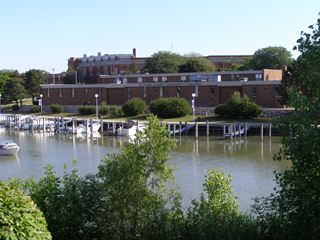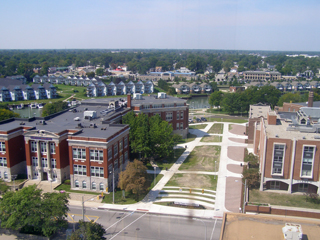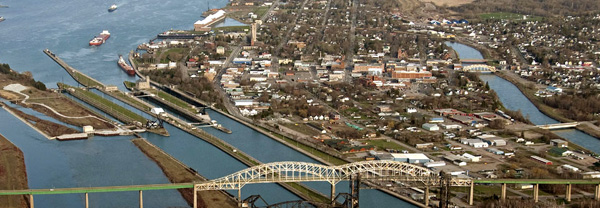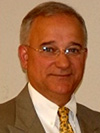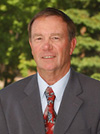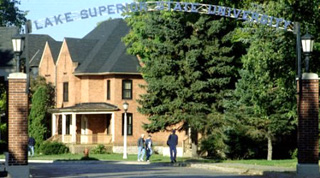By Mayor Mark J. Warba and President David Eisler
On September 1, 1884 – over 128 years ago – Woodbridge Ferris opened the Big Rapids Industrial School on S. Michigan Avenue.
For an institution that started in rented rooms on the third floor of a business building in downtown Big Rapids, Ferris State University has grown into an educational enterprise. It now has 119 buildings on the 880-acre Big Rapids campus and also in downtown Grand Rapids, as well as partner sites at 17 community colleges around the state.
The university has an operating budget of over $270 million and it employs more than 1,400 full-time employees with an annual payroll of over $120 million. Ferris has an annual net economic impact of over $90 million, with two-thirds of the spending occurring in Mecosta County, where more than 65 percent of students attend classes on the main campus, and 88 percent of Ferris faculty and staff work in Big Rapids.
Big Rapids is the seat of government for Mecosta County, with a vibrant downtown and an industrial base that continues to thrive and transform itself while creating numerous employment opportunities. The Mecosta County Medical Center consistently ranks in the Top 100 hospitals in the United States in quality performance measures, and the Roben-Hood airport continues to grow and expand.
The university and the city recognize the continuing importance of communicating and cooperating with one another, and with their partners in the community. Examples include:
1. Monthly meetings during the academic year between representatives of the university, city and Mecosta County to discuss topics such as infrastructure improvements, training opportunities with members of public safety, utilities and recycling.
2. Quarterly town-gown meetings that bring together representatives from education, local government and the community, including the university president, superintendent of public schools and mayor.
3. The “Big Event,” where Ferris State University students come together and give back to the community by performing household chores for area residents. The chores include washing windows, raking leaves, trimming bushes, small paint jobs, and more. Labor and supplies are provided completely free of charge, and last year tmore than 1,800 students volunteered at over 200 homes in the Big Rapids community.
4. The Festival of the Arts that is held throughout the month of February, where the university, in association with the Big Rapids community, brings together numerous individuals, volunteers, artists and event sponsors for a celebration of the arts, ranging from photography, to writing and music.
5. Members of the University’s administration participate in meetings with local manufacturers to say thank you for doing business in the Big Rapids community, and to look for ways to help the manufacturers, the university and the community grow.
6. Support for the United Way campaign in Mecosta and Osceola counties, helping to make the area’s United Way one of the very few in Michigan that continues to grow and meet its goal, albeit in a region that includes two of the poorest counties in the Lower Peninsula.
7. Providing assistance in other ways as needed. For example, during a period of upcoming renovation for the public library, the university library will provide services for local residents.
The city and the university have also maintained a commitment to campus and community growth and improvement, with some of the highlights including:
A. In 2001, the Ferris Library for Information, Technology and Education “FLITE” was completed, and in 2012, the Jim Crow Museum of Racist Memorabilia opened in the lower level of the library.
B. In 2004, the Granger Center for Construction and HVACR opened, with various elements of its construction and its heating and cooling systems open to view in order to facilitate learning.
C. In 2007, the city had the number 1 project in the state as part of the Vibrant Small City Initiative Program, allowing it to invest nearly $3 million to improve its downtown, including streetscape, facade improvements, way-finding signage and cultural center enhancement.
D. In 2008, the city embarked on improvements to its wastewater treatment plant, which services the university and two surrounding townships, totaling more than $7 million.
E. In 2012, the Michigan College of Optometry opened its state-of-the-art facility on the university campus. As the only College of Optometry in the state and one of just 20 in the country, the new building provides the resources the college needs to produce graduates to meet a growing need.
F. This year, the city will begin moving forward in making improvements to one of the two bridges that span the Muskegon River, increasing access to the industrial park, the riverwalk system, and local streets, at a cost of nearly $6 million.
At the Michigan Municipal League’s 2012 Convention, one of the core legislative principles that was adopted recognized how educational institutions play a central role in growing and supporting a knowledge-based economy. The legislative principal also recognized how local government must effectively collaborate with such key community stakeholders and participate as a partner in decisions that impact the community.
Big Rapids and Ferris State University are truly joined at the hip as we both realize our mutual success depends on cooperation. Together we both grow and prosper. As such, we fully support the League’s emphasis on effective town-gown initiatives. This is something we both have recognized and appreciated for more than 128 years.
Mark J. Warba is the mayor of Big Rapids and David Eisler is the president of Ferris State University.









